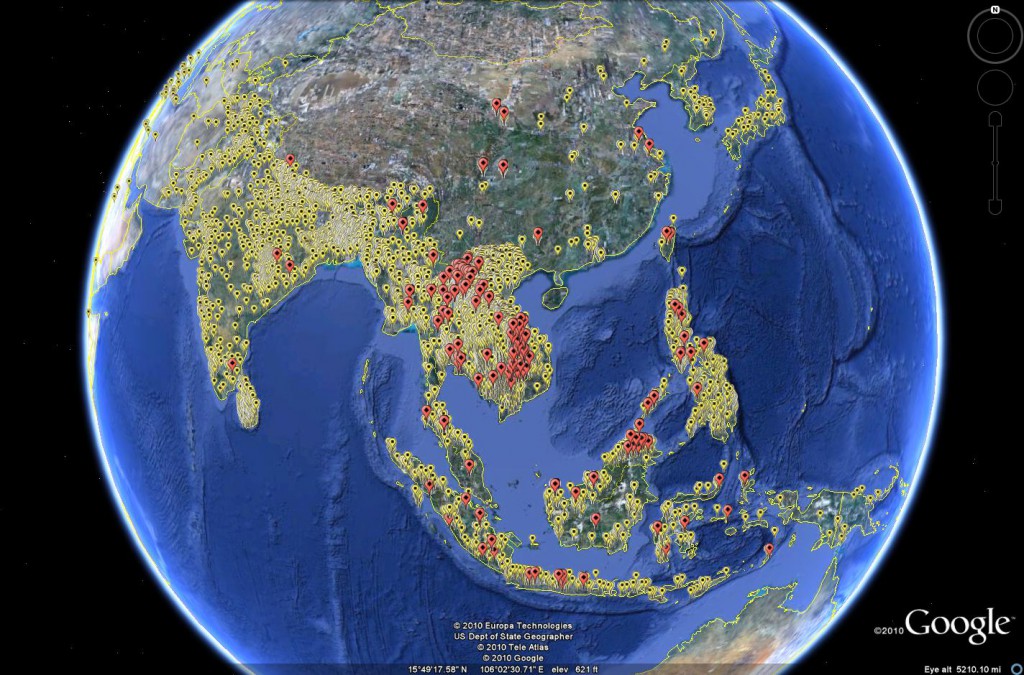- “Its flavor is like the saliva generously exchanged by lovers in kissing.” Yum!
- ECOWAS Nutrition Forum continues to sell “multi-sectoral approach to tackling under-nutrition” in West Africa.
- Six new varieties of wheat in Oman! Splitters rule.
- US scientists urged Russians to save Pavlovsk. Lotta continua.
- And here’s the Russian Housing Development Foundation’s take on the expert report. Lotta continua sempre.
- COPs may come and COPs may go — but will we be ready for the Peasant Olympics in 2012? h/t Miss Hathorn.
- Phosphates in China: waste ’em while you can?
- Book: Conservation agriculture and sustainable crop intensification in Lesotho.
- Australian almond variety not performing this year.
Nibbles:Collecting missions, Grapes, Beans, Genome, Local markets, Water
- From GBDBH, a light glimmers: browse and search records of crop collecting missions.
- “Variations in early-season temperatures may alter substantially grapevine yield formation.” For Cab Sauv at any rate.
- Mixture of beans as good as resistant variety against anthracnose disease.
- Genome inversion spurs ecotypic differentiation.
- A review of medicinal plant markets.
- Today’s huge global dataset: “threats to human water security and freshwater biodiversity in global river systems.”
The geography of black rice
Sometimes it pays to spend some time in Genebank Database Hell, if you can fight through the pain.
You may remember a piece recently about the antioxidant properties of black rice. But where does black rice come from? Well, hanging around with the Genesys and GRIN-Global crowd in the past couple of days has allowed me to come up with this map in answer to that deceptively simple question.
In yellow are all the rice accessions from Asia which have coordinates, as recorded in the IRRI database, EURISCO and GRIN. In red are the black rice accessions.
You’d have thought such a map would be pretty easy to make. But you’d be wrong. I had to get an Excel spreadsheet from IRRI with the characterization data, ((For which many thanks!)) and mash it up with the passport data in Genesys for the same accessions, and then export two separate kmz files and fiddle around in Google Earth. ((Thanks to Google for the Pro license!)) Well, they don’t call it Genebank Database Hell for nothing. But it is getting better, slowly but surely.
Nibbles: Pavlovsk, Baobab hybridization, Jackfruit, Vavilovia, Cowpea education, Lead, Bees, Banana wilt, Dariy cows, Pavlovsk, Drylands, School gardens, Genetic diversity in botanic gardens
- The value of Pavlovsk. Jeremy delivers a slap.
- CIRAD on kinky sex among the baobabs.
- “I had never heard that there were distinct varieties of the jackfruit, although of course such a thing was reasonable, so I naturally wanted very much to taste one.” Naturally.
- Wild relative of pea gets a weird hybrid in-ex situ conservation treatment.
- A Cowpea Story, an illustrative children’s book by Vicky Inniss-Palmer, tells the hopeful story of a cowpea named Catalina and her struggle to overcome illness and disease with the help of scientists. Meanwhile, scientists meet.
- Urban gardeners, beware lead. And nurture your pollinators.
- Reading this, anyone would think nobody had ever researched banana Xanthomonas wilt.
- Improved dairying in Kenya.
- Vavilov Institute’s comprehensive update on Pavlovsk.
- ICRISAT to put in place new market-oriented strategy which will use a “systems perspective in setting our priorities to ensure that all important issues along the dryland agriculture value chain are addressed.”
- Meanwhile, ASARECA asks for ideas on how to intensify one of those dryland systems in the face of climate change.
- ICIMOD promotes herbal gardens in schools.
- Botanic gardens get wrists slapped over their inattention to genetics.
Brassica bounty
Couldn’t resist today’s trifecta of Brassica papers. At the meta level, there’s “Origin and Domestication of Cole Crops (Brassica oleracea L.): Linguistic and Literary Considerations” in Economic Botany. Then some of the same authors follow up in GRACE with “AFLP analysis of genetic diversity in leafy kale (Brassica oleracea L. convar. acephala (DC.) Alef.) landraces, cultivars and wild populations in Europe.” And finally, in Plant Breeding, enjoy “The cytoplasm effect comparison between Brassica napus and Brassica carinata on floral characteristics of Brassica oleracea.” Enough to keep brassica boffins busy for weeks.
